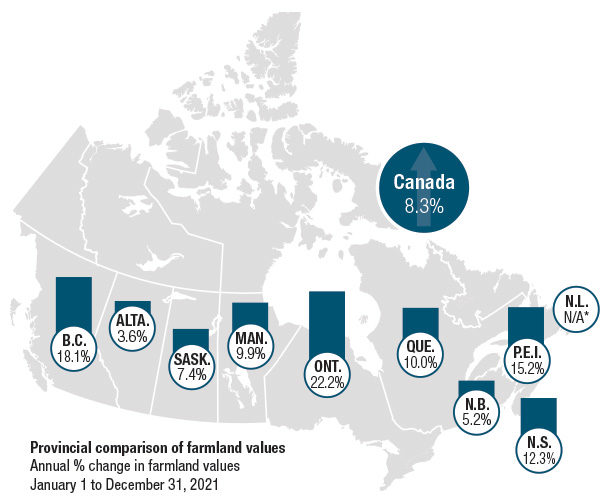Canada’s farmland values climbed in spite of impacts from pandemic supply chain disruptions and adverse weather that affected parts of the country, as Farm Credit Canada’s (FCC) Farmland Values Report showed an 8.3% national average increase in 2021.
The report, which describes changes in Canada’s farmland values from Jan. 1 to Dec. 31, 2021, covers an entire year of disruptions caused by the pandemic, as well as drought that reduced yields across much of the prairies.
FCC reported a 5.4% national average increase in 2020.
The low interest rate environment and favourable commodity prices seem to have offset some of the many challenges that could have been expected to restrain the demand for farmland and the price producers are willing to pay for land. It’s a testament to the resilience and business confidence of farm operators who are largely driving this strong Canadian farmland market.
The largest increases were recorded in Ontario and British Columbia (22.2% and 18.1%, respectively), followed by Prince Edward Island (15.2%), Nova Scotia (12.3%) and Quebec (10%).
Other provinces showed more moderate average increases, ranging from Alberta at 3.6% to Manitoba at 9.9%. Saskatchewan recorded an average increase of 7.4%, while New Brunswick showed a 5.2% average increase.
There was an insufficient number of publicly reported sales in Newfoundland and Labrador to fully assess farmland values in that province. That was also the case in Yukon, Northwest Territories and Nunavut.
Canada’s agriculture industry is still facing uncertainty; labour shortages, supply chain disruptions, geopolitical tensions, farm input inflation and incremental interest rate increases are expected this year. At the same time, FCC is forecasting that receipts of grains, oilseeds and pulses in Canada will increase in 2022, fueled by strong demand and tight global supply.
Increases in farmland values reported across the country are as wide and varied as the factors that may have influenced them. Average farmland values have increased every year since 1993; however, increases were more pronounced from 2011 to 2015 in many different regions. Since then, Canada has seen more moderate single-digit increases (less than 10%) in average farmland values.
Ontario reported the sharpest overall increase, more than quadrupling its 2020 average farmland value increase of 4.7%, while British Columbia more than doubled its average increase from the previous year. With a much smaller farmland market, Prince Edward Island’s average increase was more pronounced from one year to the next.
Land markets in Prairie provinces were somewhat tempered by adverse growing conditions, while farmland values in several regions of British Columbia were bolstered by limited supplies of available land and proximity to urban areas.
Sharp increases are often a result of local market conditions coupled with relatively favourable economic conditions. For areas that reported significant increases, strong demand for a limited supply of land played a key role in bumping up values.
Producers in many regions were buying or selling land to gain operational efficiencies and to support family farm succession plans, which contributed to a strong farmland market in Canada.
Relatively good growing conditions in Quebec, Nova Scotia and New Brunswick contributed to the farmland value increases in those provinces.
It is very important for producers to have and maintain a risk management plan that takes into account possible economic changes, ensuring their budgets have room to flex if commodity prices, yields or interest rates shift. They also need to exercise caution, especially in regions where the growth rate of farmland values exceeded that of farm income in recent years. 
For more information and insights, visit FCC - Economics










